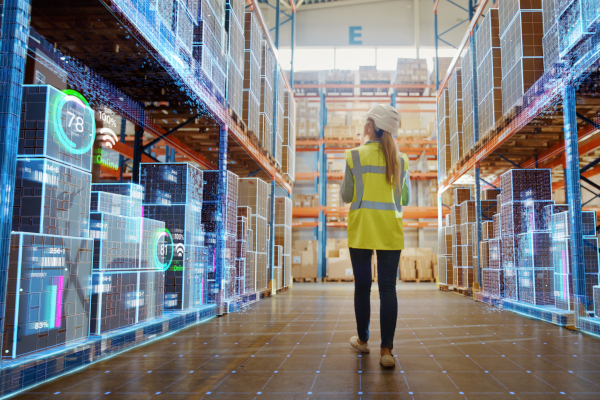As has been written previously, the supply chain is undergoing a transformation as automation takes hold. And while there are still areas where automation has yet to touch, those are becoming fewer and fewer.
Logistics is no exception. In actuality, automation in logistics has been around for many years. Things like track-and-trace capabilities were born out of technological advancements. Today, track-and-trace is a tested and productive tool that a majority of carriers and shippers have deployed, at least to some extent.
“We need to continue to focus on automating the mundane stuff that people don’t want to do anymore,” Jeannie Carpenter, senior director of global logistics at global manufacturing solutions provider Jabil, tells Supply Chain Management Review. “From a logistics standpoint, you’ve seen over the last 10 years that you can have a completely automated warehouse.”
Carpenter shared her thoughts on a number of logistics subjects in a recent interview with SCMR, noting the important role that logistics plays and the importance of automation to help streamline processes and reduce costs. With that said, though, Carpenter points to the complex nature of the supply chain and how logistics needs to be part of the solution, not the only solution.
“Looking at the full end-to-end value stream, we can’t just be siloed by the logistics function,” she says. “We may not be able to automate something in the logistics function because of an upstream process.”
People will continue to play an important role in logistics, Carpenter says, although labor challenges are persisting.
“How do we retain the right people in the traditional logistics roles, because they are probably burned out,” she says. “Retaining those people is truly, I believe, getting back to the process, looking at those inefficiencies and tackling those.”
Carpenter says technology is helping attract people to the industry, but the growth of final-mile services in recent years has increased the need exponentially.
Collaboration needed
One of the trends that came out of the COVID disruption years is the important role that logisticians now play in the C-suite. A recent report from supply chain consultancy Capterra found that while companies recognize the need to include supply chain managers (SCM) in executive-level planning discussions, only 31% of SCMs regularly meet with IT and/or operations.
“To meet these changes, businesses need to shift from strategies that prioritize cost reduction and efficiency to those that center around the customer. This will involve elevating the role of supply chain management from a ‘back of the house’ execution-only focused department to a strategic partner with a seat at the senior leadership table,” the firm said in the report.
Carpenter agrees, saying that “really tackling the end-to-end supply chain is sitting with those counterparts, not only in the supply chain, but within the organization” so gaps in information can be found and acted upon.
“You have to look at the whole supply chain and see where you have the visibility,” she says.
Traditionally, the barrier for successful logistics rested on whether items were picked up and delivered. That is no longer the case.
“I think the function is being elevated across the supply chain organization and we are having those discussions,” Carpenter says, advising people to reach “out across the organization … [and] insert yourself into the conversation and seeing how logistics can help with their problems.”
Carpenter touched on several other topics. Here are a few additional takeaways:
1. Investing in logistics means investing in communication and people. “The investment should always be the process first, and then you can continue to innovate. Invest in the process and allow the people to do it.”
2. The influx of people into logistics because of the expanding last-mile demands could be pulling workers away from other industries, creating labor shortages elsewhere. The Bureau of Labor Statistics reported there were 1.61 million truck-transportation jobs in January 2023, up 3.6% from January 2022.
3. Predictive analytics is still developing, but Carpenter says that combining it with historical data is giving the industry better insights into how predictions have paned out and creating more accurate forecasting as a result.
4. Rates continue to be challenging for transportation providers in all modes, with fluctuations continuing. “The rates will continue to do that, and we have to navigate through that. The partnerships that we have with carriers are key to that.”
5. The key to managing through the rollercoaster that is logistics remains the same, Carpenter says. “The key to surviving the peaks and valleys is true partnerships and having strategic ones. That hasn’t changed one bit.”
SC
MR


More Automation
- Tech investments bring revenue increases, survey finds
- Survey reveals strategies for addressing supply chain, logistics labor shortages
- Six Factors to Consider Before Automating Warehouses
- From Whiteboard to Warehouse: Writing an Effective Warehouse Automation RFP
- 2023 Warehouse/DC Operations Survey: Automating while upping performance
- Fast Tracking ROI: Agile Logistics through Automation, AI, and Optimization
- More Automation
Latest Podcast

 Explore
Explore
Topics
Procurement & Sourcing News
- Bridging the ESG gap in supply chain management: From ambition to action
- Israel, Ukraine aid package to increase pressure on aerospace and defense supply chains
- How CPG brands can deliver on supplier diversity promises
- How S&OP provides the answer to in-demand products
- There is still work to do to achieve supply chain stability
- Blooming success: The vital role of S&OE in nurturing global supply chains
- More Procurement & Sourcing
Latest Procurement & Sourcing Resources

Subscribe

Supply Chain Management Review delivers the best industry content.

Editors’ Picks




